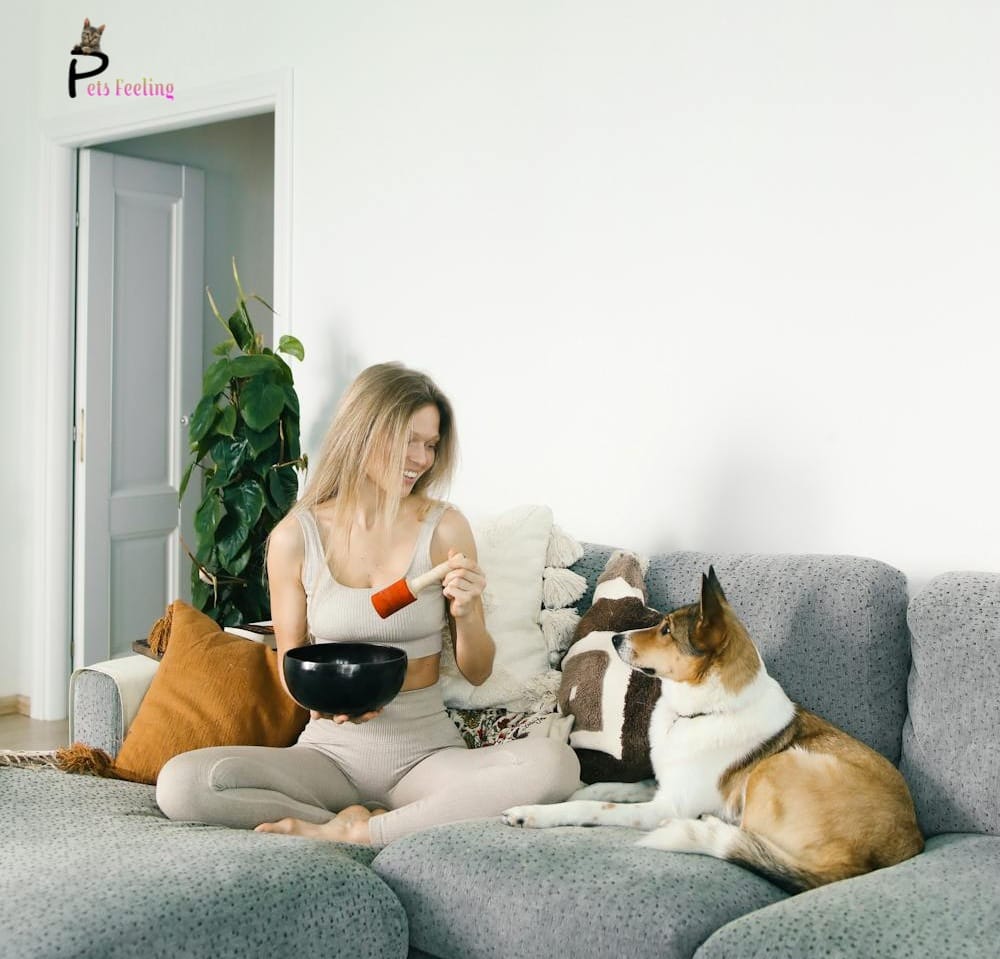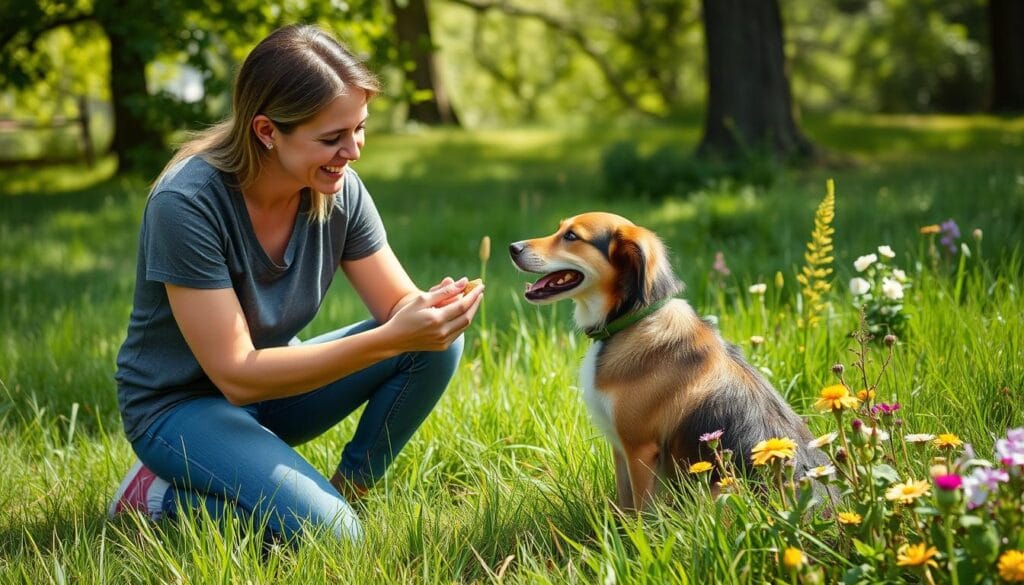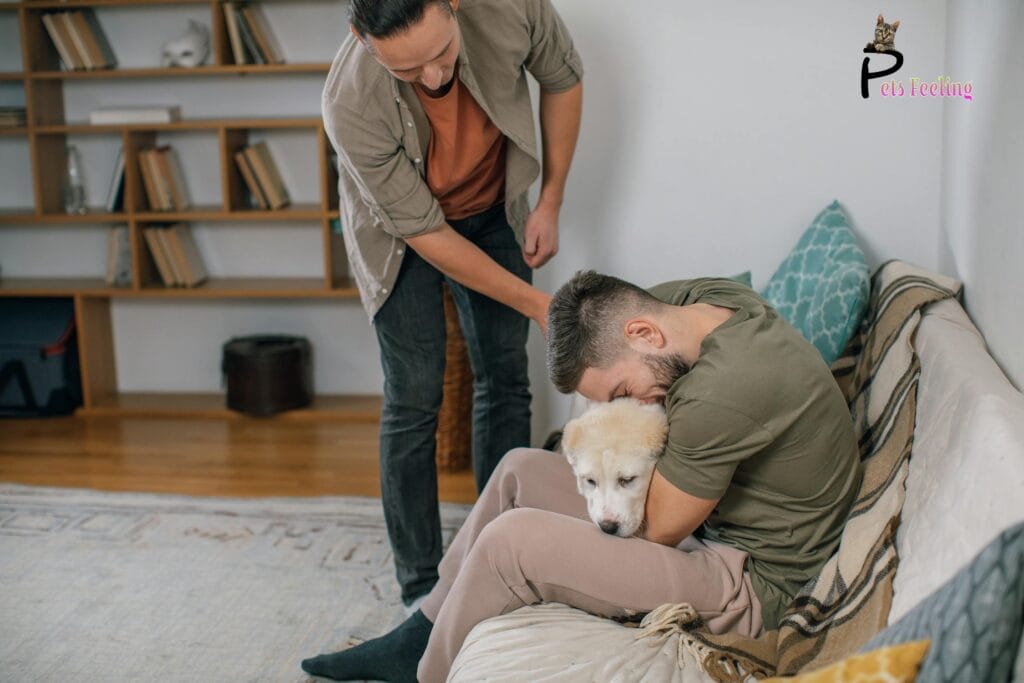Bringing a rescue dog home can be very rewarding. But, it takes patience, understanding, and time to build trust. You might ask: How can I create a strong bond with my rescue dog and help them feel safe and secure? This guide will show you the key steps to build a lasting connection and help your dog thrive. (How to Build Trust with a Rescue Dog )

Key Takeaways
- Understand your rescue dog’s unique behavioral cues and needs to build trust
- Create a safe, comfortable environment that helps your dog feel at ease
- Establish a consistent routine and set clear boundaries to provide stability
- Use positive reinforcement training to build confidence and strengthen the bond
- Be patient and allow your rescue dog the time they need to overcome past traumas
Understanding Rescue Dog Behavior
Welcoming a rescue dog into your home means understanding their unique behaviors and body language. These dogs often have a history of trauma or uncertainty. Recognizing signs of fear and anxiety helps create a safe, nurturing environment. This environment aids in building trust and confidence. (How to Build Trust with a Rescue Dog )
Recognizing Signs of Fear and Anxiety
Rescue dogs may show various behaviors when feeling uncomfortable or threatened. Common signs include a tucked tail, trembling, avoiding eye contact, excessive panting, hiding, and growling. Being attentive to these cues helps you adjust your approach, making your dog feel safer and more secure. (How to Build Trust with a Rescue Dog )
Interpreting Body Language
Canine body language is key to understanding your rescue dog’s emotional state and needs. Notice their posture, ear position, and tail movement. A relaxed, open posture with a wagging tail shows confidence and comfort. A tense, rigid body and tucked tail may indicate fear or uncertainty. Learning to read these signals helps you meet your dog’s needs and build a strong, trusting relationship. (How to Build Trust with a Rescue Dog )
| Body Language Cue | Possible Meaning |
|---|---|
| Ears forward | Interested and engaged |
| Ears back | Stressed or fearful |
| Tail wagging | Friendly and happy |
| Tail tucked | Scared or anxious |
| Relaxed, open posture | Calm and confident |
| Tense, rigid body | Nervous or defensive |
Understanding rescue dog behavior and body language allows for a patient, empathetic approach. This approach helps your dog feel safe, builds trust, and strengthens your bond. (How to Build Trust with a Rescue Dog )
Creating a Safe and Comfortable Environment
Welcoming a rescue dog into your home requires a safe and comfy space. It’s not just about the basics. It’s about creating a special place that meets their unique needs.
Start by designating a quiet, low-traffic area as their personal sanctuary. Think of a cozy corner with their bed, water, and favorite toys. This safe spot helps them feel secure when they’re feeling overwhelmed. Let them explore new spaces and meet new people at their own pace.
It’s key to minimize overwhelming stimuli in their new home. Keep it quiet, dim the lights, and slow down the activity. Introduce new family members and pets slowly, watching them closely. This helps them feel more at ease and builds trust.
Creating a calm, caring environment helps your rescue dog feel safe and secure. It’s the first step in building a strong, lasting bond with them.
| Essential Elements for a Rescue Dog’s Safe Space | Benefits |
|---|---|
| Comfortable bed or crate Familiar toys and chews Water and food bowls Calming music or white noise Minimal foot traffic and activity | Reduces stress and anxiety Helps them feel secure and in control Encourages exploration and confidence-building Facilitates a smooth transition to their new home |
Establishing a Routine and Consistency
Creating a routine and setting clear rules is crucial for trust with your rescue dog. Rescue dogs love structure and familiarity. It makes them feel safe and helps them understand their new home. A reliable schedule and clear rules bring stability, boosting your dog’s confidence and your bond.
Developing a Predictable Schedule
Consistency is vital for a rescue dog’s daily life. Try to have a set schedule for meals, walks, play, and rest. This makes your dog feel secure and less stressed. Here are some tips for a reliable routine: (How to Build Trust with a Rescue Dog )
- Maintain set mealtimes and feeding locations
- Stick to a regular exercise and potty break schedule
- Allocate specific times for training, grooming, and affection
- Establish a consistent bedtime routine, including a designated sleeping area
Maintaining Rules and Boundaries
Setting clear rules is also key. It helps your dog know what’s expected and makes them feel secure. Make sure to:
- Consistently enforce the same rules, such as not jumping on furniture or begging for food
- Establish and maintain designated spaces for your dog, such as their own bed or crate
- Use positive reinforcement training to reinforce desired behaviors
- Avoid changing rules or boundaries too frequently, as this can be confusing for your dog
By following these steps, you can help your rescue dog feel more at ease. This builds trust and strengthens your bond. Remember, patience and consistency are essential when working with a rescue dog. (How to Build Trust with a Rescue Dog )
How to Build Trust with a Rescue Dog
Building trust with a rescue dog needs patience and a gentle touch. It’s important to move at your dog’s pace and use positive training. This helps them feel safe and comfortable. By following these steps, you can build a strong bond and gain your dog’s trust. (How to Build Trust with a Rescue Dog )
Taking Things Slowly
When gaining a rescue dog’s trust, slow and steady is best. Rushing can make your dog more anxious or fearful. Instead, take things slowly and let your dog lead. Introduce yourself gently, let them come to you, and avoid sudden noises. (How to Build Trust with a Rescue Dog )
Using Positive Reinforcement Training
Positive reinforcement training is great for building confidence in dogs and gaining a rescue dog’s trust. It rewards good behavior instead of punishing bad ones. Using treats and praise helps your dog feel safe and secure, encouraging them to trust you. (How to Build Trust with a Rescue Dog )
“The key to building trust with a rescue dog is to be patient and use positive reinforcement. With time and consistency, you can help your dog feel safe and confident in your care.” (How to Build Trust with a Rescue Dog )
Remember, a patient approach to rescue dog training and positive reinforcement training for rescue dogs are key. By moving slowly and rewarding good behavior, you can build a strong, trusting bond with your rescue dog. (How to Build Trust with a Rescue Dog )

Fostering Bonding and Building Confidence
Positive interactions, playtime, and exercise are key to bonding with your rescue dog. They also help build their confidence. Enjoyable activities nurture a trusting relationship and support their emotional well-being.
Engaging in Playtime and Exercise
Playtime and exercise are vital for a strong bond with your rescue dog. They provide physical and mental stimulation. They also offer chances to connect in fun ways. (How to Build Trust with a Rescue Dog )
From playing fetch to going for walks, these moments make your dog feel safe and valued. They help your dog feel secure and loved.
- Incorporate interactive toys and games that encourage your dog to engage with you, fostering a sense of trust and cooperation.
- Participate in positive reinforcement training exercises, rewarding your dog’s desired behaviors with treats and praise to build their confidence.
- Engage in regular exercise routines, such as hiking or swimming, that allow your dog to explore their surroundings while enjoying your company.
By focusing on these activities, you create a safe and nurturing environment. Your rescue dog will feel empowered to explore the world with you.
| Bonding Activity | Benefits |
|---|---|
| Playtime | Strengthens the connection, provides mental stimulation, and builds confidence. |
| Exercise | Improves physical and mental well-being, reduces stress, and fosters a sense of security. |
| Positive Reinforcement Training | Enhances the bond, teaches desired behaviors, and boosts self-assurance. |
By making these activities part of your daily routine, you can build a strong bond with your rescue dog. This helps them gain confidence and thrive in their new home. (How to Build Trust with a Rescue Dog )
Overcoming Rescue Dog’s Past Traumas
Rescue dogs often have past experiences that make building trust slow. It’s important to provide security and understand their behavior. This helps them overcome their fears. (How to Build Trust with a Rescue Dog )
Providing a Sense of Security
Creating a safe and comfy space is crucial for a rescue dog’s anxiety. Slow introductions, gentle touch, and regular routines help. Patience and kindness are key to earning their trust and loyalty. (How to Build Trust with a Rescue Dog )
Seeking Professional Help if Necessary
At times, a rescue dog’s past may need a pro’s help. Experts in animal behavior can create a plan to build confidence in shelter dogs and comfort formerly abused animals. If your dog is struggling, don’t hesitate to get professional help. (How to Build Trust with a Rescue Dog )
“The key to helping a rescue dog is to be patient, consistent, and understanding. With time and the right approach, you can help them overcome their past and learn to trust again.” (How to Build Trust with a Rescue Dog )

Helping a rescue dog overcome past traumas is a journey of kindness and understanding. By providing a sense of security and seeking professional help if necessary, you can help your dog gain your trust and build confidence. This creates a rewarding and lasting bond.
The Importance of Patience and Consistency
Building trust with a rescue dog is a slow process that needs a lot of patience and consistency. These qualities help create a safe space for your rescue dog to learn to trust you. They also help your dog feel confident in their new home. (How to Build Trust with a Rescue Dog )
Adopting a rescue dog is challenging because they may have faced trauma or neglect. A patient approach is key when interacting with them. They need time to get used to their new home and you. If you rush, it can make them more anxious and hurt their trust.
Patience and consistency are important for building confidence in a rescue dog. A regular routine, clear rules, and positive training help them feel safe and valued. (How to Build Trust with a Rescue Dog )
Every rescue dog is unique, and you must earn their trust slowly and carefully. With patience and consistency, you can build a strong bond. This will help your rescue dog become a confident and happy companion. (How to Build Trust with a Rescue Dog )
| Qualities | Importance | Benefits |
|---|---|---|
| Patience | Allows the rescue dog to adjust at their own pace | Builds trust and reduces anxiety |
| Consistency | Provides a predictable, secure environment | Fosters a sense of safety and confidence |
By adopting these qualities, you can build a caring and supportive relationship with your rescue dog. This will help them overcome past traumas and become the loving, loyal companion they deserve to be. (How to Build Trust with a Rescue Dog )
“The best things in life are worth waiting for, and that includes the bond you’ll build with a rescue dog. With patience and consistency, you can earn their trust and transform their life – and yours – forever.” (How to Build Trust with a Rescue Dog )
Building Trust: A Gradual Process
Gaining a rescue dog’s trust takes time and understanding. It’s important to move at their pace. Use patient and consistent methods to make them feel safe and confident in your care. (How to Build Trust with a Rescue Dog )
Gradual socialization is crucial. Watch your dog’s body language to understand their fears or anxieties. Positive reinforcement training and playtime help build their confidence and loyalty. (How to Build Trust with a Rescue Dog )
Every rescue dog is different, and their trust journey varies. Keep a consistent routine and set clear boundaries. If needed, seek professional help to address past traumas with care and empathy. With patience and understanding, you can build a strong, trusting relationship with your dog.
FAQ
What are some signs that a rescue dog is fearful or anxious?
Signs of fear and anxiety in rescue dogs include cowering and trembling. They might also pant a lot, have a tucked tail, and avoid eye contact. Look out for nervous behaviors like excessive licking or pacing. It’s key to respond with patience and a gentle approach.
How can I create a safe and comfortable environment for my rescue dog?
Create a safe space with a quiet area, their own bed, toys, and water. Introduce new people and animals slowly and under supervision. Make sure they have a secure retreat to feel in control.
Why is establishing a consistent routine important for a rescue dog?
Rescue dogs love routine and predictability. It makes them feel secure. Develop a reliable schedule for feeding, walks, playtime, and rest. Clear rules and boundaries help build trust and confidence.
How can I use positive reinforcement training to build trust with my rescue dog?
Positive reinforcement training is great for building trust. Reward good behavior with treats, praise, or play. This helps them associate you with positive experiences and feel safe.
What can I do to help a rescue dog overcome past traumas?
Provide a sense of security and go at their pace. Seeking professional help if needed is also important. Be patient, compassionate, and avoid triggers that remind them of past negative experiences.
Why is it so important to be patient and consistent when building trust with a rescue dog?
Building trust with a rescue dog takes time and consistency. They need time to feel safe and learn to trust you. A calm, positive approach and a predictable routine help them overcome fears and develop confidence in you.
IMPORTANT ADDITIONS
Edited on , 22 OCT ,2024
Read more articles : https://petsfeeling.com/blog-2/
social media :
facebook : https://www.facebook.com/PetsFeeling0/
tiktok : https://www.tiktok.com/@pets.feeling
instagram : https://www.instagram.com/pets._.feeling/
youtube : https://www.youtube.com/@Pets-Feeling

